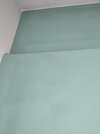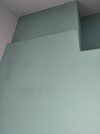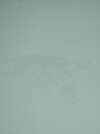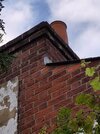- Joined
- 9 Oct 2024
- Messages
- 4
- Reaction score
- 0
- Country

I have recently had a room decorated in my old Victorian terrace house, where there is a chimney breast. The wall covering the chimney breast was previously covered with old lining paper so I was not aware of any damp issues. A few weeks after decorating during some cold and rainy weather, some damp patches appeared in the new paint in the chimney breast area.
After some reading around I am pretty sure that this is related to hygroscopic salts in the brick/plaster attracting moisture from the atmosphere. My question is, how to address this? I know there is the nuclear option, hack off the plaster and take some of the brickwork out and fix up, redecorate, but thats really not an appealing option if I can avoid it!
Also, I have seen some suggestions elsewhere that this kind of thing might be related to lack of ventilation in the chimney - would that be relevant as well? I don't understand how that would be the case here, as the damp patches seem surface level only and dry out quite quickly, I would have thought that if moisture inside the chimney was being drawn out through the bricks to the room (which is what I assume ventilation for the chimney would relate to) that the damp would be a lot more pervasive and slow to dry out, but I am a novice so not sure. I suppose its also possible that its just that the chimney breast is colder and moisture in the room condenses there in the colder areas, but it always seems to be in the same locations which makes me think its salt contamination...
Anyway, would any of these solutions help?
- some kind of damp proof lining paper
- salt neutralising treatment applied to wall, then prime and replaster
- combination of the above
- vent bricks in chimney as discussed above
Any ideas? This seems to be a common issue but I haven't yet come across anyone saying they fixed it by doing xyz..
After some reading around I am pretty sure that this is related to hygroscopic salts in the brick/plaster attracting moisture from the atmosphere. My question is, how to address this? I know there is the nuclear option, hack off the plaster and take some of the brickwork out and fix up, redecorate, but thats really not an appealing option if I can avoid it!
Also, I have seen some suggestions elsewhere that this kind of thing might be related to lack of ventilation in the chimney - would that be relevant as well? I don't understand how that would be the case here, as the damp patches seem surface level only and dry out quite quickly, I would have thought that if moisture inside the chimney was being drawn out through the bricks to the room (which is what I assume ventilation for the chimney would relate to) that the damp would be a lot more pervasive and slow to dry out, but I am a novice so not sure. I suppose its also possible that its just that the chimney breast is colder and moisture in the room condenses there in the colder areas, but it always seems to be in the same locations which makes me think its salt contamination...
Anyway, would any of these solutions help?
- some kind of damp proof lining paper
- salt neutralising treatment applied to wall, then prime and replaster
- combination of the above
- vent bricks in chimney as discussed above
Any ideas? This seems to be a common issue but I haven't yet come across anyone saying they fixed it by doing xyz..





